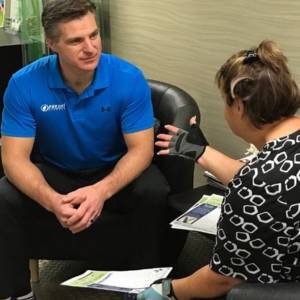Today, we will dive into the brain-muscle connection and the subject of weak muscles. One of the key things that I knew at the conceptual level, but was crystallized for me over the weekend.
One weekend, I attended a 3-day course on effective Decision Making for movement coaches. The content was focused on how to gather better information during a functional assessment with clients. And customize programming and exercises to their specific needs.
While I will spare you the technical details, it was a pretty awesome course and added another strong tool to my toolbox of skill and knowledge.
There were many great takeaways from the course, but the one thing that stands out most is the concept of weak muscles.
Our instructor Dominick made it abundantly clear that he doesn’t believe in muscle weakness in the traditional sense. Sure, people can always get stronger, but instead of “weakness”, he preferred that we use “low-quality contraction. Conversely, “strong” was “high-quality contraction”.
This may seem like a semantic argument. But most people think of strong or weak as acting in longer timeframes (i.e. weak comes from inactivity, and strength comes from “working out” over the longer term).
What we saw that weekend turned traditional thinking on its head.
Anyone with an anatomy and physiology background knows that our brain controls muscle contractions. While this is very clear and we understand the basic mechanics of how muscles activate, our understanding of the massively complex interactions that happen in the body with regard to movement, pain, compensations, injury, alignment variations, disease, stress, environmental factors, and more is still in its infancy.
During the course, we witnessed many examples of moment-to-moment changes. Changes in contraction quality levels were based on a wide range of factors that were seemingly unrelated.
For example, strong, fit people performed movements perfectly and were then unable to do it seconds later if they looked in a certain direction with their eyes.
Seriously…the only thing that changed was the direction their eyes were looking. If they looked back in the original direction, their contraction quality came back.
We saw this time and time again. For me, I was one of the test cases during the course. I’ve had left hip and right shoulder issues since a car accident about 5 years ago. During the assessment process, we determined that I was “weak as a kitten” during hip extension. But only if my ankle was in dorsiflexion (toes pulled up towards my shin). Strength was great on the same exercises when I pointed my foot down (plantar flexion).
Again, after a few patterning and activation drills (customized exercises) that took 2-3 minutes my contraction quality skyrocketed.

It was fascinating and opened up a huge range of opportunities to help my clients.
We were shown how following a few simple steps of neural patterning and activation could dramatically improve that person’s performance in the previously “low quality” position.
I mention this because many people spend time in the gym to get “stronger” or feel that they have weak muscles no matter what they do. This isn’t the case at all.
Most people just aren’t moving properly in the first place, and haven’t been shown how to maximize the use of their bodies. In my book, and the Functional Movement Coaching courses I teach, the importance of alignment and activation are driven home.
What I learned this weekend verifies the importance of body position and movement patterning, provides the knowledge to understand the process in more detail, and added simple tools to accelerate the improvement curve.
Imagine being able to get literally 10 times the results in a fraction of the time! This is a reality.
Or, you can just continue doing what you’ve been doing.
If you are already getting all the results you can imagine from your exercise program, that’s great. If that’s the case, I may suggest setting new goals! But, if you aren’t getting the results you want from exercise, there is probably a simple reason. Figuring that out is one of the best things you can do for your future self. This is where my team and I can help.
Think about what your life and body would feel like with more “strength”, confidence in your abilities, and the chance to eliminate many of the aches, pains, and physical annoyances you’ve been dealing with.
Yes, we all have them at some level, but smart people deal with them early and often.
I feel a bit like Neo in the Matrix (Red Pill or Blue Pill for those of you who haven’t seen the movie),
The choice is yours.
Should you choose quality in life, contraction, movement, and fitness we would love to help. Just book your FREE Success Coaching Session with FRESH! and let’s get started!



